Clumping bamboos going great guns
Spring is the time when most running bamboos, like black bamboo and its siblings from the genus Phyllostachys, produce new shoots. By summer, the new culms have reached their final height and have branched out. Running bamboos now pump their energy into growth underground—this is the time of year when the rhizomes “run” horizontally.
In contrast, summer is the peak shooting time for subtropical and tropical clumping bamboos. In their native habitat, this coincides with the onset of the rainy season. While in our climate summers are bone dry, supplemental irrigation ensures that our bamboos’ water needs are met as they send up one new culm after another.
Even though we live in a climate with mild winters where temperatures rarely drop below 25°F, we’re still limited as to what kind of tropical clumpers we can grow. Quite a few of the most spectacular bamboos don’t survive below 30°F, so I will forever lust after the famed Timor black bamboo (Bambusa lako) or Sacred Bali bamboo (Schizostachyum brachycladum).
Nevertheless, many Bambusa species do very well in our climate. In fact, we have five different Bambusa growing in our front yard. All of them are in the midst of their annual shooting cycle, and it’s exciting checking on their progress every day.
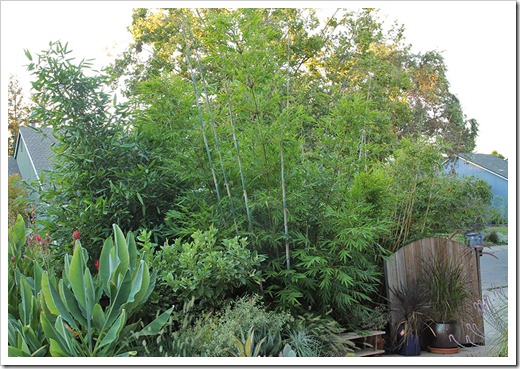 |
| Bambusa oldhamii (left), Bambusa chungii ‘Barbellata’ (middle), Bambusa multiplex ‘Alphonse Karr’ (right, behind gate) |
Oldham’s bamboo (Bambusa oldhamii)
Bambusa oldhamii is the largest clumping bamboo we can grow in our climate zone. It has the potential to grow to 50 ft. with a culm diameter of 4 in. I don’t know if it will get quite that tall here, but I’m hoping for 35-40 ft. This would give us the tree-like effect we’re looking for in front of our house. In fact, this Bambusa oldhamii replaced a tree that had to be removed due to mistletoe damage.
 |
| Bambusa oldhamii in front of our house |
Bambusa oldhamii forms a tight clump, so even a mature specimen has a relatively compact footprint (check out these photos I took in Sydney, Australia). This makes it a great choice for smaller suburban lots like ours.
Our oldhamii was planted just 1½ years ago as a 5-gallon plant, and its development has been nothing short of phenomenal. The fattest of this year’s culms is over 2 in. in diameter.
 |
| The tallest of this year’s culms… |
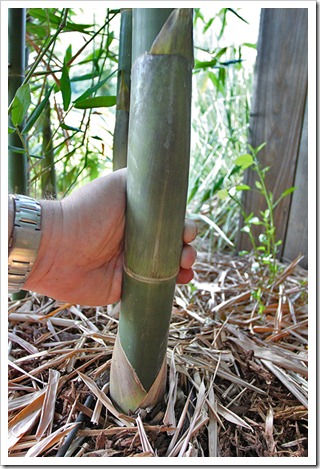 |
| …and the fattest (2 in.) |
Baby Blue bamboo (Bambusa chungii ‘Barbellata’)
As speedy as Bambusa oldhamii’s growth has been, Bambusa chungii ‘Barbellata’ has been equally impressive. Check out these posts to see its explosive development: October 2010, March 2011, July 2011.
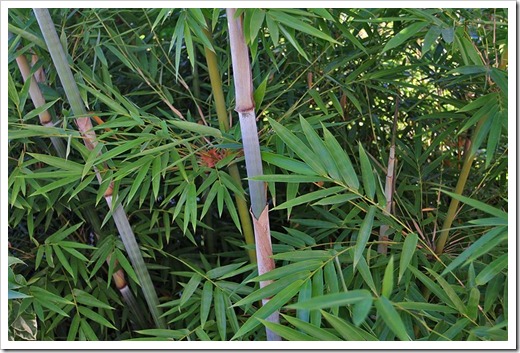 |
| New culms on Bambusa chungii ‘Barbellata’ |
New culms are covered with a white powder which gives them a bluish coloration. In my book, this is one of the most attractive of all the tropical clumpers that can be grown outside of the tropics.
The downside about Bambusa chungii ‘Barbellata’ is its availability, or lack thereof. In our neck of the woods, it grows as well as any of the common clumpers like Alphonse Karr, and yet none of the Northern California bamboo nurseries carry it. I hope this will change soon; with its gorgeous culms and its elegant leaves, this could become a very popular landscaping plant.
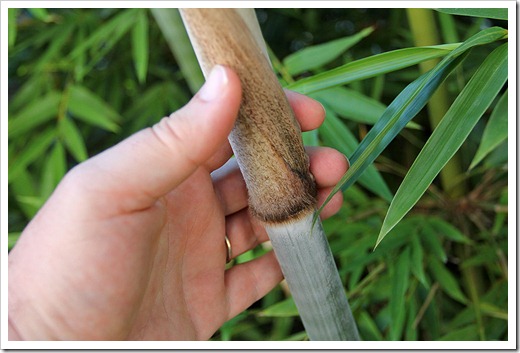 |
| Bambusa chungii ‘Barbellata’ is called Baby Blue Bamboo because of the bluish coloring of the new culms… |
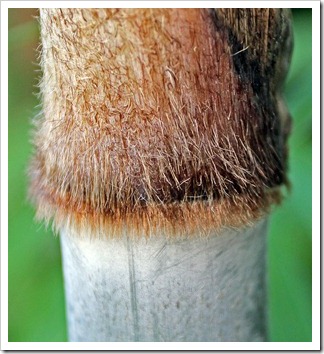 |
| …but it could also be called Hairy Bamboo! The hairy culm sheath will fall as soon as branches begin to emerge. |
Alphonse Karr bamboo (Bambusa multiplex ‘Alphonse Karr’)
Bambusa multiplex ‘Alphonse Karr’ is probably the most common clumping bamboo planted in our area. It is widely available, matures quickly, and has an attractive overall look. It is also hardy to 15°F so it can be grown in more places than other tropical clumpers. (Bambusa oldhamii and Bambusa chungii, for instance, are only rated to 21°F.)
We have two Alphonse Karrs. The one in the front yard, right behind the gate, was a large division from a local homeowner; it has been in the ground for 1½ years. The one in the backyard was bought as a 5-gallon plant from Madman Bamboo; it has been in the ground for 2 years. Both specimens are a couple of years away from their mature size when they should reach a height of 20 ft. and a culm diameter of 1½ in.
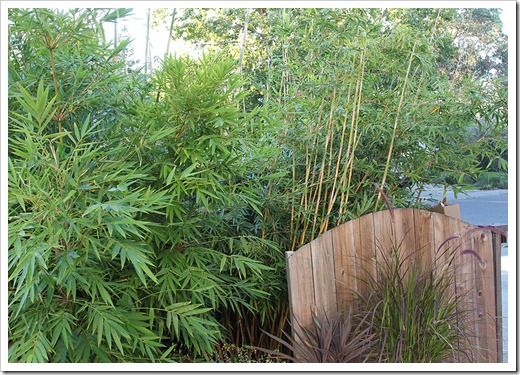 |
| Bambusa multiplex ‘Alphonse Karr’ in the front yard… |
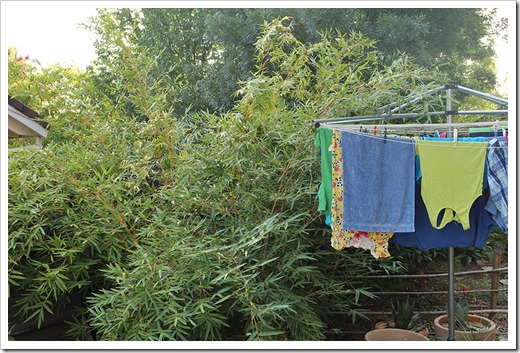 |
| …and in the back yard where its vicinity to the clothesline is an issue |
Asian Lemon bamboo (Bambusa eutuldoides ‘Viridividatta’)
Asian Lemon bamboo is a relatively recent introduction, and its availability in California is quite limited. I was lucky to find a 15-gallon plant last year and I’m happy to see that this year’s culms are bigger than last year’s. I think this specimen is still a few years away from maturing, but according to the American Bamboo Society’s Species Source List, it should reach a height of 25 ft. with a culm diameter of 1 in. (the new culms are ¾ in. already).
This is a beautiful bamboo, and the yellow coloration of the culms is much more vibrant than that of Alphonse Karr. In terms of hardiness, it’s rated to 21°F. If you come across a specimen in a nursery, grab it. You won’t be disappointed.
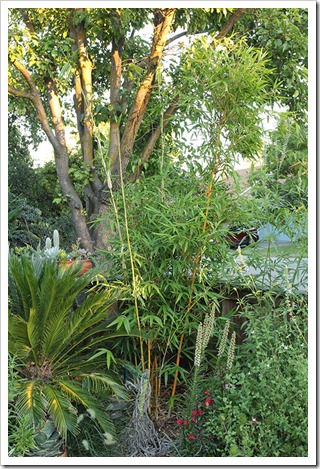 |
| Bambusa eutuldoides ‘Viridividatta’ |
| It’s easy to see why its common name is “Asian Lemon Bamboo” |
Emerald bamboo (Bambusa textilis ‘Mutabilis’)
The final clumping bamboo in front of our house is Bambusa textilis ‘Mutabilis’. It’s a form of weaver’s bamboo (Bambusa textilis) and experts are still debating as to how different it really is. In Florida, it’s being sold as emerald bamboo because of the deep green color of its culms. It’s one of the hardier Bambusa varieties, rated 18°F by the American Bamboo Society.
Emerald bamboo is also a fairly tall bamboo (to 40 ft.) with a mature culm diameter of 2½ in. It forms a very tight clump with a small footprint which allows it to be planted in relatively small spaces—like the spot between our fence and the street light (see photo below). However, I’m already planning on removing the large maidenhair grass this winter because there isn’t enough room for both of them.
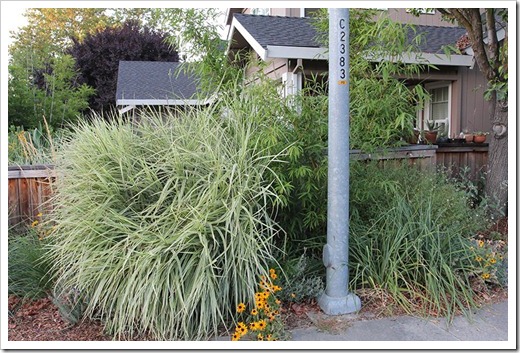 |
| Bambusa textilis ‘Mutabilis’ behind the street light |
I bought our emerald bamboo last winter from Bamboo Sourcery, which at the time was having a going-out-of-business sale (they reopened this spring). I only paid $40 for a 15-gallon plant, which is a very good deal.
This year’s culms are not only twice the diameter of the old ones, they are also remarkably beautiful. They have have whitish pinstripes—not common for emerald bamboo but I’m not complaining!
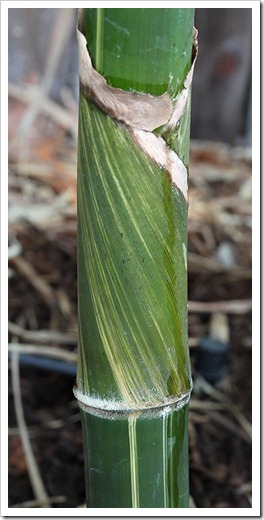 |
| Pretty impressive new culms, and beautiful striping on the culm sheaths and the actual culms. |

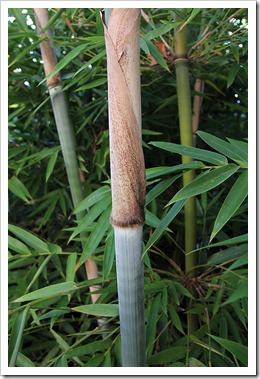
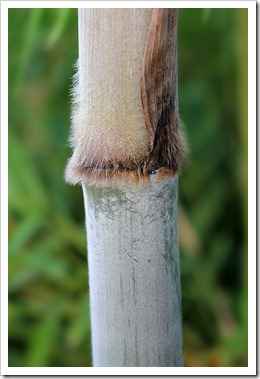
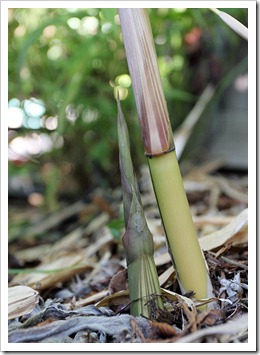
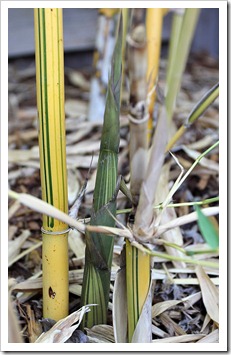
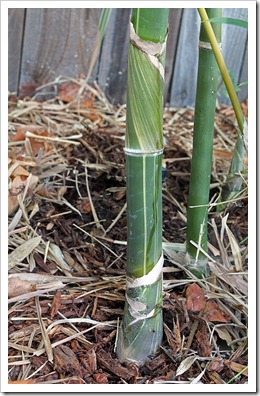

Too bad some vagrants left a beer bottle in your yard. Really ruined that photo. ;-)
ReplyDeleteI'm really tired of you clumping bamboo growers with your "the culms are 2 inches thick after only 2 months in the ground!" and your lack of worries about containment. It's like you don't even have to try. How much fun can that be?
Alan, I was going to use a soda can for size comparison, but I found this beer bottle sitting on the kitchen counter and thought it would work just as well, especially since it's from Hawaii where tropical clumpers grow particularly well :-)
ReplyDeleteI do admit we don't have to try too hard to get these bamboos to thrive. But I'm afraid they'll get too big (yeah, laugh at me!). I think I'll cut back on fertilizing next year.
Bambusa heaven! Shame none of them are reliably hardy here :(
ReplyDeleteI think the standard unit of measurement should either be a soda can or a bottle of wine :)